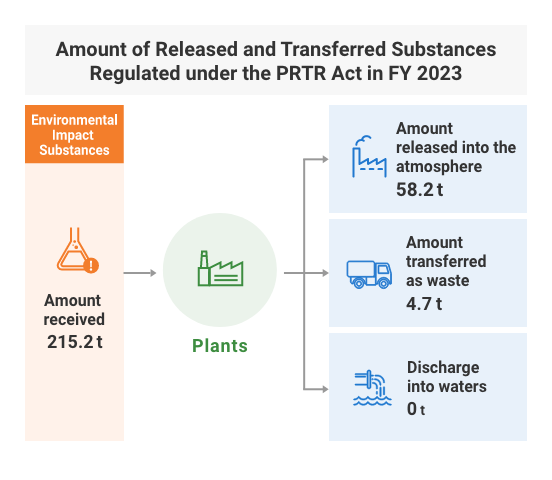Reduction of Environmental Impact Substances
Basic Approach
To reduce environmental impact substances and waste, KOITO commits in its Environmental Policy to strive to "develop and establish new environmentally friendly technologies and products throughout the product life cycle" and "minimize the environmental impact and use of resources and energy in the manufacturing process," and promoting relevant activities.
KOITO has set quantitative reduction targets for VOC emissions in the midterm priority activities. Activities are being implemented to reduce emissions while checking progress.
We are committed to actively engage in reducing environmental impact substances to materialize "Eco-friendly Manufacturing for People and the Earth."
Life Cycle Assessment (LCA)
KOITO is developing products with the goal of reducing environmental impact substances with a comprehensive viewpoint based on the life cycle covering R&D, production, transport, consumption, and disposal.
Efforts in Production Processes
Some raw materials, such as paints and chemicals, as well as secondary materials used in the production processes, contain chemical substances that have negative environmental impacts. KOITO is reducing these environmental impact substances by reinforcing the management of the amount to use and emit, improving consumption efficiency, and using alternative substances.
Management of Substances Regulated under the PRTR Act

KOITO is keeping track of the amount of substances regulated under the PRTR Act handled or transferred in the production processes while managing them appropriately as well as reducing the amount to use and replacing them with alternative substances.
In FY 2022, KOITO have handled six substances subject to PRTR Act (Class 1 designated substances), including toluene and styrene. The amount of these substances handled was 215.2 tons, and the amount of atmospheric emissions and transfers as waste was 62.9 tons.
Reduction of Volatile Organic Compounds (VOC)
As a target for FY 2026, KOITO is working to maintain VOC emissions below 299 tons, the amount in FY 2019, a base year, and to further reduce emissions per unit*1.
In FY 2022, VOC emissions were reduced by 36% compared to FY 2019. In addition, we have achieved 13% reduction in emissions per unit compared to FY 2019.
In addition, KOITO has not used the three major hazardous air pollutants*2 since we had eliminated its use in March 2003.
※1 VOC emissions per unit: The amount of VOC emissions (kg) per production in monetary amount (million yen)
※2 Hazardous air pollutants: Dichloromethane, trichloroethylene, and tetrachloroethylene
Trends in VOC emissions and emissions per unit of production
| data | unit | FY 2018 | FY 2019 | FY 2020 | FY 2021 | FY 2022 | FY 2023 |
|---|---|---|---|---|---|---|---|
| VOC emissions | t | 307 | 299 | 272 | 220 | 192 | 173 |
| basic unit | kg/million yen | 13.6 | 13.9 | 12.8 | 12.9 | 12.1 | 10.9 |
